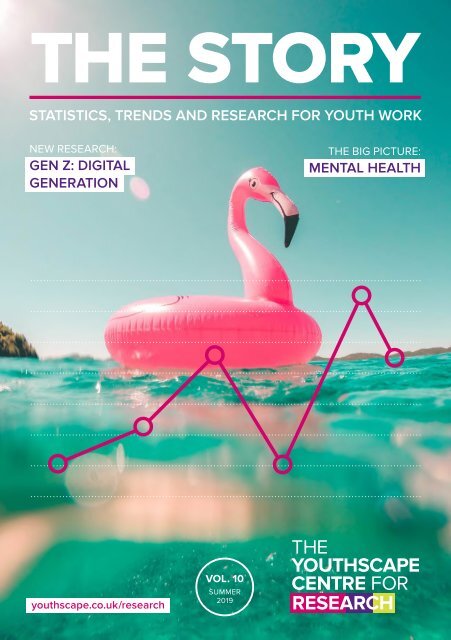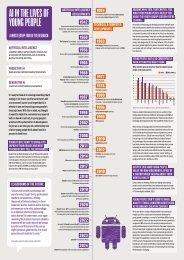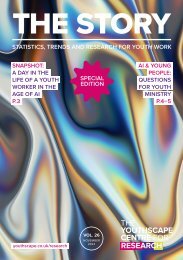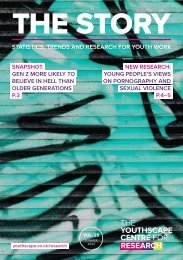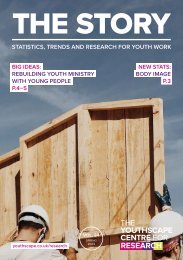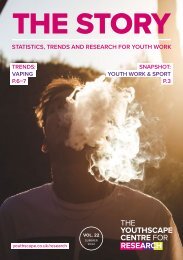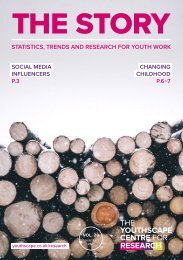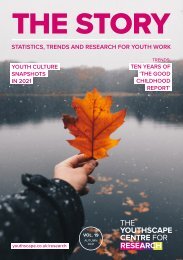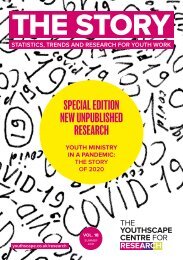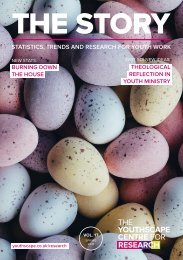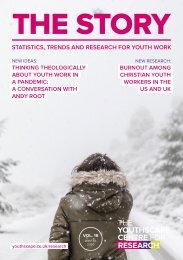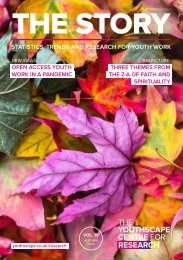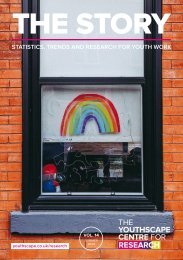the-story-vol-10
You also want an ePaper? Increase the reach of your titles
YUMPU automatically turns print PDFs into web optimized ePapers that Google loves.
THE STORY<br />
STATISTICS, TRENDS AND RESEARCH FOR YOUTH WORK<br />
NEW RESEARCH:<br />
GEN Z: DIGITAL<br />
GENERATION<br />
THE BIG PICTURE:<br />
MENTAL HEALTH<br />
youthscape.co.uk/research<br />
VOL. <strong>10</strong><br />
SUMMER<br />
2019
WELCOME TO<br />
THE STORY<br />
In each issue of The Story we bring you some of<br />
<strong>the</strong> latest research related to young people and<br />
youth work. In <strong>the</strong> coming pages you will find<br />
statistics, research and trends which we hope<br />
will interest you, challenge you and inform your<br />
work with young people.<br />
In this edition we highlight new research from<br />
Youth for Christ and compare <strong>the</strong>ir findings with<br />
o<strong>the</strong>r research into social media use (p.2–3).<br />
We share research on hope in young people’s<br />
lives, and where it springs from (p.4–5), and we<br />
look at <strong>the</strong> big picture of trends in mental health<br />
disorders amongst teenagers in England (p.6–7).<br />
And to top it all off, our first Venn diagram on <strong>the</strong><br />
back page! We’re pretty sure you can do better,<br />
and if so please let us see too (#ywdiagrams).<br />
Don’t forget that you can now subscribe to<br />
The Story for £<strong>10</strong> a year, and we will send all<br />
four physical copies to your door as <strong>the</strong>y are<br />
published. It’s <strong>the</strong> only way to get your hands on<br />
<strong>the</strong> stats poster…<br />
To sign up for future editions of<br />
THE STORY, and to receive printed<br />
versions, visit youthscape.co.uk/<br />
research/<strong>the</strong>-<strong>story</strong><br />
IN THIS ISSUE:<br />
NEW RESEARCH<br />
Gen Z: Digital Generation<br />
NEW IDEAS<br />
Pivoting Toward Hope<br />
THE BIG PICTURE<br />
Mental Health<br />
YOUTH WORK DIAGRAMS<br />
EVERYTHING YOU NEED TO<br />
KNOW ABOUT… SCHOOL<br />
P.2–3<br />
P.4–5<br />
P.6–7<br />
P.8<br />
REVERSE<br />
YOUTH FOR CHRIST OFCOM SO?<br />
PREFERRED PLATFORMS<br />
YouTube was <strong>the</strong> most popular social<br />
networking platform (77%) followed<br />
by Facebook (49%), Snapchat (48%),<br />
Instagram (46%) and WhatsApp<br />
(37%).<br />
AUTHENTICITY ONLINE<br />
85% of <strong>the</strong> YFC sample said ‘yes’<br />
<strong>the</strong>y can be au<strong>the</strong>ntic online. Of <strong>the</strong><br />
152 who said ‘No’, around half said<br />
<strong>the</strong>y were ei<strong>the</strong>r more confident<br />
online or <strong>the</strong>y could say things <strong>the</strong>y<br />
couldn’t say in person.<br />
IMPACT OF SOCIAL MEDIA<br />
When asked how social media<br />
affects your mood and <strong>the</strong> way you<br />
see yourself, young people were<br />
much more positive than negative.<br />
56% said <strong>the</strong>y feel happier when<br />
<strong>the</strong>y use it and only 19% said <strong>the</strong>y<br />
compared <strong>the</strong>mselves to o<strong>the</strong>rs<br />
(highest ranking positive and<br />
negative responses).<br />
YOUTUBE CONTENT – VLOGGERS<br />
The top five sites used by those<br />
with a social media profile were<br />
Facebook (72%), Instagram (65%),<br />
Snapchat (62%), Whatsapp (62%)<br />
and YouTube (35%). When asked<br />
which site <strong>the</strong>y used most often,<br />
<strong>the</strong> top five were Facebook (31%)<br />
Snapchat (31%), Instagram (23%)<br />
YouTube (7%) and WhatsApp (5%).<br />
Just over half (54%) agreed that <strong>the</strong><br />
images or videos that people post<br />
online make <strong>the</strong>ir life look more<br />
interesting than it is; less than one in<br />
ten (6%) disagreed.<br />
When asked about <strong>the</strong> positive and<br />
negative effects of social media,<br />
12–15 year old users as a group<br />
were more positive than negative,<br />
with 66% saying it makes <strong>the</strong>m feel<br />
closer to friends and 54% saying it<br />
makes <strong>the</strong>m feel happy all or most of<br />
<strong>the</strong> time.<br />
You get different answers<br />
depending on your exact questions<br />
and <strong>the</strong> profile of those you ask.<br />
Though Facebook is top dog, its<br />
popularity is declining, and though<br />
YouTube is less popular in <strong>the</strong><br />
Ofcom study <strong>the</strong>ir data shows<br />
it is still used by 89% of those<br />
surveyed.<br />
Toge<strong>the</strong>r <strong>the</strong>se findings suggest<br />
that au<strong>the</strong>nticity is highly valued<br />
by young people – <strong>the</strong>y largely<br />
see <strong>the</strong>mselves as au<strong>the</strong>ntic even<br />
as <strong>the</strong>y recognise inau<strong>the</strong>nticity in<br />
o<strong>the</strong>r people’s posts.<br />
Across both studies young people<br />
saw social media positively on<br />
balance. So we shouldn’t take an<br />
automatically negative tone on<br />
this issue.<br />
Lucie Shuker<br />
Director of Research, Youthscape<br />
NEW RESEARCH:<br />
Gen Z: Digital Generation<br />
Youth for Christ have recently published <strong>the</strong><br />
second of three research reports exploring<br />
<strong>the</strong> culture of young people – ‘Gen Z: Digital<br />
Generation’. They surveyed <strong>10</strong>01 11–18 year olds,<br />
asking <strong>the</strong>m a range of questions about <strong>the</strong>ir<br />
use of social media, and YouTube in particular.<br />
We’ve highlighted some of <strong>the</strong> statistics we found<br />
most interesting and compared <strong>the</strong>m to ano<strong>the</strong>r<br />
study released by Ofcom in 2019 ‘Children and<br />
parents: Media use and attitudes report’ that<br />
focused on 12–15 year olds.<br />
There is lots more to dig out from <strong>the</strong> YFC<br />
study, and you can find it at https://yfc.co.uk/<br />
digitalgeneration/<br />
Vlogger videos were <strong>the</strong> second<br />
most popular type of YouTube<br />
content (56%) after music vids/<br />
streaming (59%). The most popular<br />
reason for watching vloggers was<br />
‘talking about <strong>the</strong>ir passions’ (61%),<br />
followed by ‘pranks’ (60%) and <strong>the</strong>n<br />
‘challenges’ (55%).<br />
CONTENT CREATION<br />
39% of <strong>the</strong> YFC sample said <strong>the</strong>y<br />
uploaded <strong>the</strong>ir own content to<br />
YouTube, with <strong>the</strong> most popular<br />
content being gaming videos (23%),<br />
music/singing videos (23%) and<br />
funny videos (12%).<br />
Three-quarters of YouTube users<br />
aged 12–15 say <strong>the</strong>y watch funny<br />
videos/ jokes/ pranks/ challenges<br />
(74%) or music videos (74%) with half<br />
watching vloggers (52%). This has<br />
risen from 40% saying <strong>the</strong>y watch<br />
vloggers on YouTube a year ago.<br />
82% of <strong>the</strong> 12–15 year olds surveyed<br />
had undertaken at least one of 11<br />
creative activities online, with <strong>the</strong><br />
most popular being changing or<br />
editing a photo (59%), followed by<br />
making a video at 47%. Ano<strong>the</strong>r 20%<br />
make <strong>the</strong>ir own music.<br />
Vlogging is on <strong>the</strong> rise, and<br />
humour and au<strong>the</strong>nticity seem to<br />
be big draws in this space. Both<br />
<strong>the</strong> YFC study and Ofcom’s (2017)<br />
media report found that <strong>the</strong> top<br />
reason for choosing content was<br />
‘it’s funny’.<br />
We don’t have comparative<br />
generational data to see if this is<br />
unique to youth, but <strong>the</strong>se figures<br />
do highlight that young people<br />
are creating, not just consuming<br />
content.<br />
P.2<br />
P.3
NEW IDEAS:<br />
Pivoting Toward Hope<br />
Francisca Ireland-Verwoerd<br />
and Mary Elizabeth Moore of<br />
Boston University published<br />
a paper last year called<br />
‘Pivoting toward Hope:<br />
Interplay of Imagination,<br />
Fear and Life Experience’<br />
in <strong>the</strong> Journal of Youth and<br />
Theology. They drew on<br />
interviews and focus groups<br />
with 75 young people aged<br />
12–24 from <strong>the</strong> USA and UK,<br />
who predominantly identified<br />
as Christian – exploring <strong>the</strong>ir<br />
experiences of hope.<br />
The authors establish early on that <strong>the</strong>y are<br />
discussing hope as a <strong>the</strong>ological virtue – not<br />
naïve optimism in <strong>the</strong> face of evil, nor a<br />
psychological construct that helps people feel<br />
positive. They draw on three <strong>the</strong>ologians – John<br />
Macquarrie, Jurgen Moltmann and Leonardo Boff<br />
– whose work argues that hope is actively chosen.<br />
It’s not just that hope is found in <strong>the</strong> grittiness<br />
of people’s lives, but that hope is actually<br />
‘drawn from <strong>the</strong> forces of life that flow within <strong>the</strong><br />
devastations of <strong>the</strong>ir existential worlds’ (p.70)<br />
In o<strong>the</strong>r words, hope comes from God and is<br />
wrestled out of our darkest experiences.<br />
Young people’s narratives echoed this. The<br />
participants lived ‘fragile lives in a fragile world’<br />
and yet <strong>the</strong>mes of searching for hope were<br />
present in more than 95% of <strong>the</strong> interviews<br />
and focus groups (p.64). When asked to name<br />
<strong>the</strong>ir concerns, <strong>the</strong> young people identified:<br />
broken family and community relationships;<br />
violence; broken global relationships;<br />
condemnation toward homosexuality; poverty<br />
and consumerism; racism and sexism; drugs and<br />
alcohol and ecological destruction (from <strong>the</strong> most<br />
to <strong>the</strong> least frequent).<br />
Young people’s personal experiences related<br />
to <strong>the</strong>ir understanding and awareness of <strong>the</strong>se<br />
wider issues, and <strong>the</strong>y reformed experiences<br />
of struggle and fear into a ‘platform of hope’.<br />
The researchers highlighted a range of<br />
examples where “hopeful reconstruction often<br />
propelled <strong>the</strong>m into a trajectory where <strong>the</strong>y saw<br />
<strong>the</strong>mselves addressing larger social issues that<br />
were close to <strong>the</strong>ir own stories” (p. 68)<br />
Chung-hee, who grew up in a<br />
family in which his fa<strong>the</strong>r beat his<br />
mo<strong>the</strong>r, envisions himself as a global<br />
peacemaker.<br />
Calvin, who is African American and<br />
has experienced years of overt and<br />
covert racial taunts, wants to address<br />
<strong>the</strong> “hateful violence” in our world.<br />
Duk-hwan, who grew up immersed<br />
in a culture of drinking, smoking and<br />
fighting, wants to be a business man<br />
who shapes <strong>the</strong> world to be more<br />
peaceful for all people.<br />
Valerie, whose boyfriend is hooked<br />
on drugs, sees herself as helping<br />
people to break <strong>the</strong>ir drug habits<br />
and to develop communities that<br />
minimise temptations.<br />
The study revealed that <strong>the</strong> very things that<br />
directly troubled young people were also <strong>the</strong><br />
areas where <strong>the</strong>y pivoted toward hope – by<br />
imagining an alternative future. Although <strong>the</strong><br />
young people didn’t consistently refer to God,<br />
<strong>the</strong> researchers found that hope was found<br />
more often where <strong>the</strong>y had an active imagination<br />
and a sense of something (God, or spirituality)<br />
beyond <strong>the</strong>mselves.<br />
Finally, <strong>the</strong> paper also highlighted <strong>the</strong> fragility<br />
of hope, acknowledging how easily it can be<br />
overwhelmed by fear, and <strong>the</strong> importance<br />
of imagination as a factor that enables or<br />
encourages young people to make decisions<br />
to hope. They identified five insights for youth<br />
workers, from <strong>the</strong> research.<br />
Young people…<br />
1. Learn from <strong>the</strong>ir life experience, and need<br />
maximum opportunities to reflect deeply on<br />
those experiences with o<strong>the</strong>rs<br />
2. Learn from <strong>the</strong> social contexts in which <strong>the</strong>y<br />
live, and <strong>the</strong>ir experience can be stretched<br />
with pedagogies that expand <strong>the</strong>ir horizons<br />
3. Have formative life experiences which can<br />
become platforms of hope<br />
4. Are capable of imaginatively transforming<br />
challenging and potentially damaging life<br />
experiences into a hopeful outlook for <strong>the</strong><br />
social issues that concern <strong>the</strong>m<br />
5. Learn from being in positions of responsibility<br />
and leadership, and need mentors to listen,<br />
guide, and reflect with <strong>the</strong>m on <strong>the</strong>se roles.<br />
The authors conclude:<br />
“What we can say<br />
definitively here is that<br />
hope is a <strong>the</strong>ological<br />
construct that holds<br />
great meaning to<br />
young people, and<br />
that its function in <strong>the</strong>ir<br />
lives is not only to lift<br />
<strong>the</strong>ir spirits but also to<br />
sharpen <strong>the</strong>ir critiques<br />
of life-destroying<br />
realities in families,<br />
religious communities,<br />
and o<strong>the</strong>r social<br />
contexts and to fire <strong>the</strong>ir<br />
determination to change<br />
<strong>the</strong> world.” (p.71)<br />
P.4 P.5
THE BIG PICTURE<br />
Mental Health Disorders<br />
These figures are from ‘Mental Health of<br />
Children and Young People in England, 2017’<br />
which was published in November 2018. This<br />
survey series provides England’s best source<br />
of data on trends in child mental health , and<br />
follows surveys carried out in 1999 and 2004,<br />
meaning we now have comparable data for 5<br />
to 15 year olds living in England across three<br />
decades. The 2017 survey spans <strong>the</strong> transition<br />
into adulthood by covering 17 to 19 year olds<br />
for <strong>the</strong> first time.<br />
There has been an upward<br />
trend in <strong>the</strong> prevalence of any<br />
disorder for 11–15 year olds.<br />
The likelihood of having a<br />
disorder increases with age,<br />
and amongst older girls.<br />
Emotional disorders are most<br />
common, and particularly<br />
affect older girls.<br />
• Amongst all 11–19 year olds,<br />
emotional disorders were <strong>the</strong> most<br />
common type of disorder (<strong>10</strong>.4%), and<br />
of <strong>the</strong>se, anxiety related disorders<br />
were <strong>the</strong> most common (9.1%).<br />
• In girls, prevalence increased sharply<br />
with age. At 22.4%, <strong>the</strong> rate of<br />
emotional disorders among 17 to 19<br />
year old girls was almost three times<br />
higher than in boys (7.9%) of <strong>the</strong><br />
same age.<br />
O<strong>the</strong>r disorders.<br />
• The 2017 survey was <strong>the</strong> first in <strong>the</strong><br />
series to include Body Dysmorphic<br />
Disorder (BDD) where a person<br />
spends a lot of time worrying about<br />
flaws in <strong>the</strong>ir appearance that are<br />
often unnoticeable to o<strong>the</strong>rs.<br />
• It was most prevalent in girls aged 11<br />
to 16 (1.9%) and 17 to 19 (5.6%).<br />
Characteristics of young<br />
people with a disorder.<br />
This data is not broken down by age,<br />
so includes all 5–19 year olds.<br />
• White British 5 to 19 year olds were<br />
about three times more likely (14.9%)<br />
than Black/Black British (5.6%) or<br />
Asian/Asian British (5.2%) children to<br />
have a disorder.<br />
• Living in a low–income household or<br />
with a parent in receipt of incomerelated<br />
benefits was associated<br />
with higher rates of mental disorder<br />
in children. However, <strong>the</strong>re was no<br />
association with neighbourhood<br />
deprivation.<br />
• Children with poor general health,<br />
special educational needs, or children<br />
with a parent with poor mental health<br />
or in receipt of a disability-related<br />
benefit, were more likely to have a<br />
mental disorder than o<strong>the</strong>r children.<br />
• Rates of mental disorder were higher<br />
in children living in households with<br />
less healthy family functioning.<br />
Nearly one in seven teenagers has a<br />
disorder now, compared to one in nine<br />
in 1999.<br />
• 1999 – 11.4%<br />
• 2004 – 12.4%<br />
• 2017 – 13.6%<br />
• 9.5% of 5 to <strong>10</strong> year olds<br />
• 14.4% of 11 to 16 year olds<br />
• 16.9% of 17 to 19 year olds<br />
Boys (14.3%) and girls (14.4%) aged<br />
11 to 16 were equally likely to have a<br />
disorder, but among 17 to 19 year olds,<br />
girls (23.9%) were more than twice<br />
as likely as boys (<strong>10</strong>.3%) to have a<br />
disorder.<br />
• About one in fifty (2.1%) 11 to 19 year<br />
olds was identified with ano<strong>the</strong>r<br />
type of disorder, such as an eating<br />
disorder (0.6%) or autism (1%). Overall<br />
rates have remained stable.<br />
P.6<br />
P.7
THE VENN<br />
DIAGRAM OF<br />
CHRISTIAN<br />
YOUTH WORK<br />
Spends summer in a field<br />
Druid<br />
Fruit picker<br />
Wears a hoodie<br />
Christian<br />
Youth<br />
Worker<br />
Underpaid<br />
Construction<br />
worker<br />
Taxi driver<br />
For more<br />
#youthworkdiagrams<br />
follow us on Twitter<br />
@YWresearch<br />
Knows all <strong>the</strong> local<br />
McDonalds<br />
TWITTER POLL: COLLECTIVE NOUNS<br />
Bute Mills, 74 Bute Street,<br />
Luton, LU1 2EY<br />
hello@youthscape.co.uk<br />
01582 877220<br />
Registered charity no. <strong>10</strong>81754.<br />
Registered company no. 3939801<br />
registered in England, a company<br />
limited by guarantee.<br />
We’ve all been <strong>the</strong>re. Wanting to tell someone about <strong>the</strong> large<br />
group of young people who showed up to hang out, just as you<br />
were about to close up shop. But what’s <strong>the</strong> right word? After<br />
consulting Instagram for some options, we asked Twitter ‘What’s<br />
<strong>the</strong> collective noun for young people?’<br />
16%<br />
21%<br />
A SCURRY<br />
36% A POTENTIAL<br />
27% AN INSPIRATION<br />
A HASHTAG<br />
“So anyway, I was literally turning closing <strong>the</strong> door behind me,<br />
when a whole potential of <strong>the</strong>m showed up…”<br />
P.8


